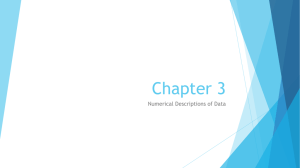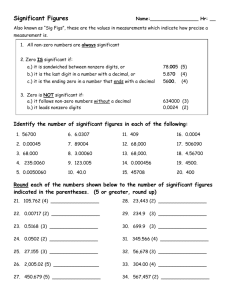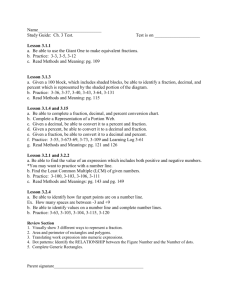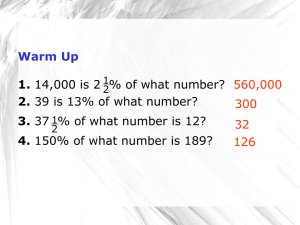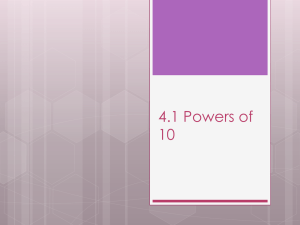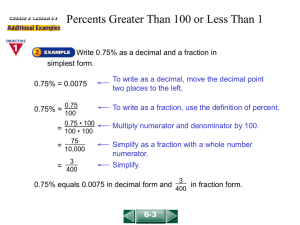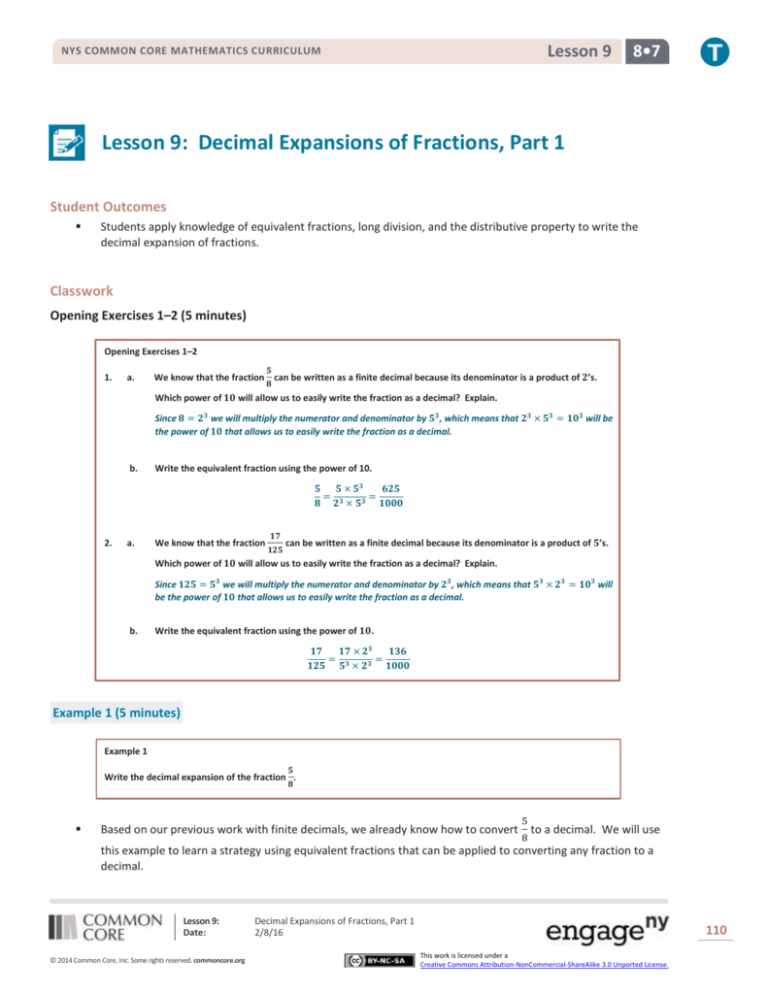
Lesson 9
NYS COMMON CORE MATHEMATICS CURRICULUM
8•7
Lesson 9: Decimal Expansions of Fractions, Part 1
Student Outcomes
Students apply knowledge of equivalent fractions, long division, and the distributive property to write the
decimal expansion of fractions.
Classwork
Opening Exercises 1–2 (5 minutes)
Opening Exercises 1–2
1.
a.
𝟓
We know that the fraction can be written as a finite decimal because its denominator is a product of 𝟐’s.
𝟖
Which power of 𝟏𝟎 will allow us to easily write the fraction as a decimal? Explain.
Since 𝟖 = 𝟐𝟑 we will multiply the numerator and denominator by 𝟓𝟑 , which means that 𝟐𝟑 × 𝟓𝟑 = 𝟏𝟎𝟑 will be
the power of 𝟏𝟎 that allows us to easily write the fraction as a decimal.
b.
Write the equivalent fraction using the power of 10.
𝟓
𝟓 × 𝟓𝟑
𝟔𝟐𝟓
=
=
𝟖 𝟐𝟑 × 𝟓𝟑 𝟏𝟎𝟎𝟎
2.
a.
We know that the fraction
𝟏𝟕
𝟏𝟐𝟓
can be written as a finite decimal because its denominator is a product of 𝟓’s.
Which power of 𝟏𝟎 will allow us to easily write the fraction as a decimal? Explain.
Since 𝟏𝟐𝟓 = 𝟓𝟑 we will multiply the numerator and denominator by 𝟐𝟑 , which means that 𝟓𝟑 × 𝟐𝟑 = 𝟏𝟎𝟑 will
be the power of 𝟏𝟎 that allows us to easily write the fraction as a decimal.
b.
Write the equivalent fraction using the power of 𝟏𝟎.
𝟏𝟕
𝟏𝟕 × 𝟐𝟑
𝟏𝟑𝟔
= 𝟑
=
𝟏𝟐𝟓 𝟓 × 𝟐𝟑 𝟏𝟎𝟎𝟎
Example 1 (5 minutes)
Example 1
Write the decimal expansion of the fraction
𝟓
𝟖
.
Based on our previous work with finite decimals, we already know how to convert
5
8
to a decimal. We will use
this example to learn a strategy using equivalent fractions that can be applied to converting any fraction to a
decimal.
Lesson 9:
Date:
© 2014 Common Core, Inc. Some rights reserved. commoncore.org
Decimal Expansions of Fractions, Part 1
2/8/16
110
This work is licensed under a
Creative Commons Attribution-NonCommercial-ShareAlike 3.0 Unported License.
8•7
Lesson 9
NYS COMMON CORE MATHEMATICS CURRICULUM
What is true about these fractions and why?
5 10 50
,
,
8 16 80
5
The fractions are equivalent. In all cases, when the numerator and denominator of are multiplied by
the same factor it produces one of the other fractions. For example,
5×2
8×2
=
10
16
8
and
5×10
8×10
=
50
80
.
What would happen if we chose 103 as this factor? We will still produce an equivalent fraction, but note how
we use the factor of 103 in writing the decimal expansion of the fraction.
5 5 × 103
1
=
× 3
8
8
10
5000
1
=
× 3
8
10
Now we use what we know about division with remainders for
5000
8
:
625 × 8 + 0
1
× 3
8
10
0
1
= (625 + ) × 3
8
10
1
= 625 × 3
10
625
= 3
10
= 0.625
=
Because of our work with Opening Exercise 1, we knew ahead of time that using 103 will help us achieve our
goal. However, any power of 10 would achieve the same result. Assume we used 105 instead. Do you think
our answer would be the same?
Yes, it should be the same, but I would have to do the work to check it.
Let’s verify that our result would be the same if we used 105 .
5 5 × 105
1
=
× 5
8
8
10
500000
1
=
× 5
8
10
62500 × 8 + 0
1
=
× 5
8
10
0
1
= (62500 + ) × 5
8
10
1
= 62500 × 5
10
62500
=
105
= 0.62500
= 0.625
Using 105 resulted in the same answer. Now we know that we can use any power of 10 with the method of
converting a fraction to a decimal.
Lesson 9:
Date:
© 2014 Common Core, Inc. Some rights reserved. commoncore.org
Decimal Expansions of Fractions, Part 1
2/8/16
111
This work is licensed under a
Creative Commons Attribution-NonCommercial-ShareAlike 3.0 Unported License.
Lesson 9
NYS COMMON CORE MATHEMATICS CURRICULUM
8•7
This process of selecting a power of 10 to use is similar to putting zeroes after the decimal point when we do
the long division. You do not quite know how many zeroes you will need, and if you put extra that’s ok! Using
lower powers of 10 can make things more complicated. It is similar to not including enough zeroes when
doing the long division. For that reason, it is better to use a higher power of 10 because we know the extra
zeroes will not change the value of the fraction nor its decimal expansion.
Example 2 (5 minutes)
Example 2
Write the decimal expansion of the fraction
𝟏𝟕
𝟏𝟐𝟓
.
We go through the same process to convert
need to use 103 to write
17
125
17
125
to a finite decimal. We know from Opening Exercise 2 that we
as a finite decimal, but from the last example we know that any power of 10 will
work:
17
17 × 103
1
=
× 3
125
125
10
What do we do next?
Since 17 × 103 = 17,000, we need to do division with remainder for
17000
125
.
Do the division and write the next step.
17000
125
= 136, then
17
125
=
136×125+0
125
×
1
103
Check to make sure all students have the equation above; then instruct them to finish the work and write
17
125
as a finite
decimal.
= 136 ×
136
103
= 0.136
1
103
=
Verify that students have the correct decimal; then work on Example 3.
Example 3 (7 minutes)
Example 3
Write the decimal expansion of the fraction
Lesson 9:
Date:
© 2014 Common Core, Inc. Some rights reserved. commoncore.org
𝟑𝟓
𝟏𝟏
.
Decimal Expansions of Fractions, Part 1
2/8/16
112
This work is licensed under a
Creative Commons Attribution-NonCommercial-ShareAlike 3.0 Unported License.
Lesson 9
NYS COMMON CORE MATHEMATICS CURRICULUM
Now we apply this strategy to a fraction,
35
, that is not a finite decimal. How do
11
you know it’s not a finite decimal?
4
example like .
3
When we do the division with remainder, we will likely get a remainder,
where the first two examples had a remainder of 0.
Let’s use 106 to make sure we get enough decimal digits in order to get a good
idea of what the infinite decimal is:
35 35 × 106
1
=
× 6
11
11
10
What do we do next?
Since 35 × 106 = 35,000,000, we need to do division with remainder for
35,000,000
11
.
4 4 × 102
1
=
× 2
3
3
10
133 × 3 + 1
1
=
× 2
3
10
133 × 3 1
1
=(
+ )× 2
3
3
10
1
1
= (133 + ) × 2
3
10
1
1
1
= 133 × 2 + × 2
10
3 10
133
1
1
= 2 + ( × 2)
10
3 10
1
1
= 1.33 + ( × 2 )
3 10
We need to determine what numbers make the following statement true:
35,000,000 =
Scaffolding:
Consider using a simpler
We know that the fraction will not be a finite decimal because the
denominator is not a product of 2’s and/or 5’s.
What do you think the difference will be in our work?
8•7
× 11 +
.
3,181,818 and 2 would give us 35,000,000 = 3,181,818 × 11 + 2.
With this information, we can continue the process:
35 3181818 × 11 + 2
1
=
× 6
11
11
10
3181818 × 11 2
1
=(
+ )× 6
11
11
10
2
1
= (3181818 + ) × 6
11
10
1
2
1
= 3181818 × 6 +
×
10
11 106
3181818
2
1
=
+ ( × 6)
106
11 10
2
1
= 3.181818 + ( × 6 )
11 10
At this point we have a fairly good estimation of the decimal expansion of
2
35
11
as 3.181818. But we need to
2
1
×
). We know that
< 1.
11 106
11
consider the value of (
By the Basic Inequality, we know that
2
1
1
× 6 <1× 6
11 10
10
2
1
1
×
<
11 106 106
Which means that the value of
2
11
×
1
106
is less than 0.000001, and we have confirmed that 3.181818 is a
good estimation of the infinite decimal that is equal to
Lesson 9:
Date:
© 2014 Common Core, Inc. Some rights reserved. commoncore.org
35
.
11
Decimal Expansions of Fractions, Part 1
2/8/16
113
This work is licensed under a
Creative Commons Attribution-NonCommercial-ShareAlike 3.0 Unported License.
Lesson 9
NYS COMMON CORE MATHEMATICS CURRICULUM
8•7
Example 4 (8 minutes)
Example 4
𝟔
Write the decimal expansion of the fraction .
𝟕
6
Let’s write the decimal expansion of . Will it be a finite or infinite decimal? How do you know?
7
We know that the fraction will not be a finite decimal because the denominator is not a product of 2’s
and/or 5’s.
We want to make sure we get enough decimal digits in order to get a good idea of what the infinite decimal is.
What power of 10 should we use?
Accept any power of 10 students give. Since we know it’s an infinite decimal, 106 should be sufficient
to make a good estimate of the value of
6
35
, but any power of 10 greater than 6 will work too. The
11
work below uses 10 .
Using 106 we have
6 6 × 106
1
=
× 6
7
7
10
What do we do next?
Since 6 × 106 = 6,000,000, we need to do division with remainder for
7
.
Determine which numbers make the following statement true:
6,000,000 =
6,000,000
×7+
857,142 and 6 would give us 6,000,000 = 857,142 × 7 + 6
Now we know that
6 857142 × 7 + 6
1
=
× 6
7
7
10
6
Finish the work to write the decimal expansion of .
7
Sample response:
6
857142 × 7 6
1
=(
+ )× 6
7
7
7
10
6
1
= (857142 + ) × 6
7
10
1
6
1
= 857142 × 6 + ( × 6 )
10
7 10
857142
6
1
=
+ ( × 6)
106
7 10
6
1
= 0.857142 + ( × 6 )
7 10
Lesson 9:
Date:
© 2014 Common Core, Inc. Some rights reserved. commoncore.org
Decimal Expansions of Fractions, Part 1
2/8/16
114
This work is licensed under a
Creative Commons Attribution-NonCommercial-ShareAlike 3.0 Unported License.
Lesson 9
NYS COMMON CORE MATHEMATICS CURRICULUM
8•7
Again we can verify how good our estimate is using the Basic Inequality:
6
<1
7
6
1
1
× 6 <1× 6
7 10
10
6
1
1
×
<
7 106 106
6
Therefore,
7
×
1
106
< 0.000001 and stating that
6
7
= 0.857142 is a good estimate.
Exercises 3–5 (5 minutes)
Students complete Exercises 3–5 independently or in pairs. Allow students to use a calculator to check their work.
Exercises 3–5
3.
a.
Choose a power of ten to use to convert this fraction to a decimal:
𝟒
𝟏𝟑
. Explain your choice.
Choices will vary. The work shown below uses the factor 𝟏𝟎𝟔 . Students should choose a factor of at least
𝟏𝟎𝟒 in order to get an approximate decimal expansion and a small remainder that will not greatly affect the
value of the number.
b.
Determine the decimal expansion of
𝟒
𝟏𝟑
and verify you are correct using a calculator.
𝟔
𝟒
𝟒 × 𝟏𝟎
𝟏
=
× 𝟔
𝟏𝟑
𝟏𝟑
𝟏𝟎
𝟒, 𝟎𝟎𝟎, 𝟎𝟎𝟎
𝟏
=
× 𝟔
𝟏𝟑
𝟏𝟎
𝟒, 𝟎𝟎𝟎, 𝟎𝟎𝟎 = 𝟑𝟎𝟕, 𝟔𝟗𝟐 × 𝟏𝟑 + 𝟒
The decimal expansion of
4.
Write the decimal expansion of
𝟒
𝟏𝟑
𝟏
𝟏𝟏
is approximately 𝟎. 𝟑𝟎𝟕𝟔𝟗𝟐.
. Verify you are correct using a calculator.
𝟔
𝟏
𝟏 × 𝟏𝟎
𝟏
=
× 𝟔
𝟏𝟏
𝟏𝟏
𝟏𝟎
𝟏, 𝟎𝟎𝟎, 𝟎𝟎𝟎
𝟏
=
× 𝟔
𝟏𝟏
𝟏𝟎
𝟏, 𝟎𝟎𝟎, 𝟎𝟎𝟎 = 𝟗𝟎, 𝟗𝟎𝟗 × 𝟏𝟏 + 𝟏
The decimal expansion of
𝟏
𝟏𝟏
Lesson 9:
Date:
© 2014 Common Core, Inc. Some rights reserved. commoncore.org
𝟒
𝟑𝟎𝟕, 𝟔𝟗𝟐 × 𝟏𝟑 + 𝟒
𝟏
=
× 𝟔
𝟏𝟑
𝟏𝟑
𝟏𝟎
𝟑𝟎𝟕, 𝟔𝟗𝟐 × 𝟏𝟑 𝟒
𝟏
=(
+ )× 𝟔
𝟏𝟑
𝟏𝟑
𝟏𝟎
𝟒
𝟏
= (𝟑𝟎𝟕, 𝟔𝟗𝟐 + ) × 𝟔
𝟏𝟑
𝟏𝟎
𝟏
𝟒
𝟏
= 𝟑𝟎𝟕, 𝟔𝟗𝟐 × 𝟔 + ( × 𝟔 )
𝟏𝟎
𝟏𝟑 𝟏𝟎
𝟑𝟎𝟕, 𝟔𝟗𝟐
𝟒
𝟏
=
+ ( × 𝟔)
𝟏𝟎𝟔
𝟏𝟑 𝟏𝟎
𝟒
𝟏
= 𝟎. 𝟑𝟎𝟕𝟔𝟗𝟐 + ( × 𝟔 )
𝟏𝟑 𝟏𝟎
𝟏
𝟗𝟎, 𝟗𝟎𝟗 × 𝟏𝟏 + 𝟏
𝟏
=
× 𝟔
𝟏𝟏
𝟏𝟏
𝟏𝟎
𝟗𝟎, 𝟗𝟎𝟗 × 𝟏𝟏 𝟏
𝟏
=(
+ )× 𝟔
𝟏𝟏
𝟏𝟏
𝟏𝟎
𝟏
𝟏
= (𝟗𝟎, 𝟗𝟎𝟗 + ) × 𝟔
𝟏𝟏
𝟏𝟎
𝟏
𝟏
𝟏
= 𝟗𝟎, 𝟗𝟎𝟗 × 𝟔 + ( × 𝟔 )
𝟏𝟎
𝟏𝟏 𝟏𝟎
𝟗𝟎, 𝟗𝟎𝟗
𝟏
𝟏
=
+ ( × 𝟔)
𝟏𝟎𝟔
𝟏𝟏 𝟏𝟎
𝟏
𝟏
= 𝟎. 𝟎𝟗𝟎𝟗𝟎𝟗𝟎 + ( × 𝟔 )
𝟏𝟏 𝟏𝟎
is approximately 𝟎. 𝟎𝟗𝟎𝟗𝟎𝟗𝟎.
Decimal Expansions of Fractions, Part 1
2/8/16
115
This work is licensed under a
Creative Commons Attribution-NonCommercial-ShareAlike 3.0 Unported License.
Lesson 9
NYS COMMON CORE MATHEMATICS CURRICULUM
5.
Write the decimal expansion of
𝟏𝟗
𝟐𝟏
. Verify you are correct using a calculator.
𝟏𝟗 𝟏𝟗 × 𝟏𝟎𝟖
𝟏
=
× 𝟖
𝟐𝟏
𝟐𝟏
𝟏𝟎
𝟏𝟗𝟎𝟎𝟎𝟎𝟎𝟎𝟎𝟎
𝟏
=
× 𝟖
𝟐𝟏
𝟏𝟎
𝟏, 𝟗𝟎𝟎, 𝟎𝟎𝟎, 𝟎𝟎𝟎 = 𝟗𝟎, 𝟒𝟕𝟔, 𝟏𝟗𝟎 × 𝟐𝟏 + 𝟏𝟎
The decimal expansion of
𝟏𝟗
𝟐𝟏
8•7
𝟏𝟗 𝟗𝟎𝟒𝟕𝟔𝟏𝟗𝟎 × 𝟐𝟏 + 𝟏𝟎
𝟏
=
× 𝟖
𝟐𝟏
𝟐𝟏
𝟏𝟎
𝟗𝟗𝟎𝟒𝟕𝟔𝟏𝟗𝟎 × 𝟐𝟏 𝟏𝟎
𝟏
=(
+ )× 𝟖
𝟐𝟏
𝟐𝟏
𝟏𝟎
𝟏𝟎
𝟏
= (𝟗𝟎𝟒𝟕𝟔𝟏𝟗𝟎 + ) × 𝟖
𝟐𝟏
𝟏𝟎
𝟏
𝟏𝟎
𝟏
= 𝟗𝟎𝟒𝟕𝟔𝟏𝟗𝟎 × 𝟖 + ( × 𝟖 )
𝟏𝟎
𝟐𝟏 𝟏𝟎
𝟗𝟎𝟒𝟕𝟔𝟏𝟗𝟎
𝟏𝟎
𝟏
=
+ ( × 𝟖)
𝟏𝟎𝟖
𝟐𝟏 𝟏𝟎
𝟏𝟎
𝟏
= 𝟎. 𝟗𝟎𝟒𝟕𝟔𝟏𝟗𝟎 + ( × 𝟖 )
𝟐𝟏 𝟏𝟎
is approximately 𝟎. 𝟗𝟎𝟒𝟕𝟔𝟏𝟗𝟎.
Closing (5 minutes)
Summarize, or ask students to summarize, the main points from the lesson:
We know how to write the decimal expansion for any fraction.
Using what we know about equivalent fractions, we can multiply a fraction by a power of 10 large enough to
give us enough decimal digits to estimate the decimal expansion of a fraction.
We know that the amount we do not include in the decimal expansion is a very small amount that will not
change the value of the number in any meaningful way.
Lesson 9:
Date:
© 2014 Common Core, Inc. Some rights reserved. commoncore.org
Decimal Expansions of Fractions, Part 1
2/8/16
116
This work is licensed under a
Creative Commons Attribution-NonCommercial-ShareAlike 3.0 Unported License.
Lesson 9
NYS COMMON CORE MATHEMATICS CURRICULUM
8•7
Lesson Summary
Multiplying a fraction’s numerator and denominator by the same power of 10 to determine its decimal expansion is
similar to including extra zeroes to the right of a decimal when using the long division algorithm. The method of
multiplying by a power of 10 reduces the work to whole number division.
𝟓
Example: We know that the fraction has an infinite decimal expansion because the denominator is not a product
𝟑
of 2’s and/or 5’s. Its decimal expansion is found by the following procedure:
𝟓 𝟓 × 𝟏𝟎𝟐
𝟏
=
× 𝟐
𝟑
𝟑
𝟏𝟎
𝟏𝟔𝟔 × 𝟑 + 𝟐
𝟏
=
× 𝟐
𝟑
𝟏𝟎
𝟏𝟔𝟔 × 𝟑 𝟐
𝟏
=(
+ )× 𝟐
𝟑
𝟑
𝟏𝟎
𝟐
𝟏
= (𝟏𝟔𝟔 + ) × 𝟐
𝟑
𝟏𝟎
𝟏𝟔𝟔
𝟐
𝟏
=
+ ( × 𝟐)
𝟏𝟎𝟐
𝟑 𝟏𝟎
𝟐
𝟏
= 𝟏. 𝟔𝟔 + ( × 𝟐 )
𝟑 𝟏𝟎
𝟏
𝟐
𝟏
= 𝟏𝟔𝟔 × 𝟐 + × 𝟐
𝟏𝟎
𝟑 𝟏𝟎
Multiply numerator and denominator by 𝟏𝟎𝟐
Rewrite the numerator as a product of a number multiplied by the denominator
Rewrite the first term as a sum of fractions with the same denominator
Simplify
Use the Distributive Property
Simplify
Simplify the first term using what you know about place value
𝟐
𝟑
Notice that the value of the remainder, ( ×
𝟏
𝟏𝟎𝟐
)=
𝟐
̅, is quite small and does not add much value to
= 𝟎. 𝟎𝟎𝟔
𝟑𝟎𝟎
𝟓
the number. Therefore, 𝟏. 𝟔𝟔 is a good estimate of the value of the infinite decimal for the fraction .
𝟑
Exit Ticket (5 minutes)
Lesson 9:
Date:
© 2014 Common Core, Inc. Some rights reserved. commoncore.org
Decimal Expansions of Fractions, Part 1
2/8/16
117
This work is licensed under a
Creative Commons Attribution-NonCommercial-ShareAlike 3.0 Unported License.
Lesson 9
NYS COMMON CORE MATHEMATICS CURRICULUM
Name
8•7
Date
Lesson 9: Decimal Expansions of Fractions, Part 1
Exit Ticket
1.
Write the decimal expansion of
2.
Write the decimal expansion of
823
40
48
21
Lesson 9:
Date:
© 2014 Common Core, Inc. Some rights reserved. commoncore.org
.
.
Decimal Expansions of Fractions, Part 1
2/8/16
118
This work is licensed under a
Creative Commons Attribution-NonCommercial-ShareAlike 3.0 Unported License.
Lesson 9
NYS COMMON CORE MATHEMATICS CURRICULUM
8•7
Exit Ticket Sample Solutions
1.
Write the decimal expansion of
𝟖𝟐𝟑
𝟒𝟎
.
𝟐𝟑 𝟖𝟐𝟑 × 𝟏𝟎𝟑
𝟏
=
× 𝟑
𝟒𝟎
𝟒𝟎
𝟏𝟎
𝟖𝟐𝟑𝟎𝟎𝟎
𝟏
=
× 𝟑
𝟒𝟎
𝟏𝟎
𝟐𝟎𝟓𝟕𝟓 × 𝟒𝟎 + 𝟏
𝟏
=
× 𝟑
𝟒𝟎
𝟏𝟎
𝟏
𝟏
= (𝟐𝟎𝟓𝟕𝟓 + ) × 𝟑
𝟒𝟎
𝟏𝟎
𝟏
𝟏
𝟏
= 𝟐𝟎𝟓𝟕𝟓 × 𝟑 +
×
𝟏𝟎
𝟒𝟎 𝟏𝟎𝟑
𝟐𝟎𝟓𝟕𝟓
𝟏
𝟏
=
+ ( × 𝟑)
𝟏𝟎𝟑
𝟒𝟎 𝟏𝟎
= 𝟐𝟎. 𝟓𝟕𝟓
The decimal expansion of
2.
𝟖𝟐𝟑
𝟒𝟎
is approximately 𝟐𝟎. 𝟓𝟕𝟓.
Write the decimal expansion of
𝟒𝟖
.
𝟐𝟏
𝟒𝟖 𝟒𝟖 × 𝟏𝟎𝟔
𝟏
=
× 𝟔
𝟐𝟏
𝟐𝟏
𝟏𝟎
𝟒𝟖𝟎𝟎𝟎𝟎𝟎𝟎
𝟏
=
× 𝟔
𝟐𝟏
𝟏𝟎
𝟒𝟖, 𝟎𝟎𝟎, 𝟎𝟎𝟎 = 𝟐, 𝟐𝟖𝟓, 𝟕𝟏𝟒 × 𝟐𝟏 + 𝟔
The decimal expansion of
𝟒𝟖
𝟐𝟏
𝟒𝟖 𝟐𝟐𝟖𝟓𝟕𝟏𝟒 × 𝟐𝟏 + 𝟔
𝟏
=
× 𝟔
𝟐𝟏
𝟐𝟏
𝟏𝟎
𝟐𝟐𝟖𝟓𝟕𝟏𝟒 × 𝟐𝟏 𝟔
𝟏
=(
+ )× 𝟔
𝟐𝟏
𝟐𝟏
𝟏𝟎
𝟔
𝟏
= (𝟐𝟐𝟖𝟓𝟕𝟏𝟒 + ) × 𝟔
𝟐𝟏
𝟏𝟎
𝟏
𝟔
𝟏
= 𝟐𝟐𝟖𝟓𝟕𝟏𝟒 × 𝟔 + ( × 𝟔 )
𝟏𝟎
𝟐𝟏 𝟏𝟎
𝟐𝟐𝟖𝟓𝟕𝟏𝟒
𝟔
𝟏
=
+ ( × 𝟔)
𝟏𝟎𝟔
𝟐𝟏 𝟏𝟎
𝟔
𝟏
= 𝟐. 𝟐𝟖𝟓𝟕𝟏𝟒 + ( × 𝟔 )
𝟐𝟏 𝟏𝟎
is approximately 𝟐. 𝟐𝟖𝟓𝟕𝟏𝟒.
Problem Set Sample Solutions
1.
a.
Choose a power of ten to convert this fraction to a decimal:
𝟒
𝟏𝟏
. Explain your choice.
Choices will vary. The work shown below uses the factor 𝟏𝟎𝟔 . Students should choose a factor of at least
𝟏𝟎𝟒 in order to get an approximate decimal expansion and notice that the decimal expansion repeats.
Lesson 9:
Date:
© 2014 Common Core, Inc. Some rights reserved. commoncore.org
Decimal Expansions of Fractions, Part 1
2/8/16
119
This work is licensed under a
Creative Commons Attribution-NonCommercial-ShareAlike 3.0 Unported License.
Lesson 9
NYS COMMON CORE MATHEMATICS CURRICULUM
b.
Determine the decimal expansion of
𝟒
𝟏𝟏
and verify you are correct using a calculator.
𝟒
𝟒 × 𝟏𝟎𝟔
𝟏
=
× 𝟔
𝟏𝟏
𝟏𝟏
𝟏𝟎
𝟒𝟎𝟎𝟎𝟎𝟎𝟎
𝟏
=
× 𝟔
𝟏𝟏
𝟏𝟎
𝟒, 𝟎𝟎𝟎, 𝟎𝟎𝟎 = 𝟑𝟔𝟑, 𝟔𝟑𝟔 × 𝟏𝟏 + 𝟒
The decimal expansion of
2.
𝟒
𝟏𝟏
Write the decimal expansion of
𝟓
𝟏𝟑
. Verify you are correct using a calculator.
𝟓, 𝟎𝟎𝟎, 𝟎𝟎𝟎 = 𝟑𝟖𝟒, 𝟔𝟏𝟓 × 𝟏𝟑 + 𝟓
3.
𝟓
𝟏𝟑
𝟐𝟑
𝟑𝟗
. Verify you are correct using a calculator.
𝟐𝟑 𝟐𝟑 × 𝟏𝟎𝟔
𝟏
=
× 𝟔
𝟑𝟗
𝟑𝟗
𝟏𝟎
𝟐𝟑𝟎𝟎𝟎𝟎𝟎𝟎
𝟏
=
× 𝟔
𝟑𝟗
𝟏𝟎
𝟐𝟑, 𝟎𝟎𝟎, 𝟎𝟎𝟎 = 𝟓𝟖𝟗, 𝟕𝟒𝟑 × 𝟑𝟗 + 𝟐𝟑
𝟐𝟑
𝟑𝟗
Lesson 9:
Date:
© 2014 Common Core, Inc. Some rights reserved. commoncore.org
𝟓
𝟑𝟖𝟒𝟔𝟏𝟓 × 𝟏𝟑 + 𝟓
𝟏
=
× 𝟔
𝟏𝟑
𝟏𝟑
𝟏𝟎
𝟑𝟖𝟒𝟔𝟏𝟓 × 𝟏𝟑 𝟓
𝟏
=(
+ )× 𝟔
𝟏𝟑
𝟏𝟑
𝟏𝟎
𝟓
𝟏
= (𝟑𝟖𝟒𝟔𝟏𝟓 + ) × 𝟔
𝟏𝟑
𝟏𝟎
𝟏
𝟓
𝟏
= 𝟑𝟖𝟒𝟔𝟏𝟓 × 𝟔 + ( × 𝟔 )
𝟏𝟎
𝟏𝟑 𝟏𝟎
𝟑𝟖𝟒𝟔𝟏𝟓
𝟓
𝟏
=
+ ( × 𝟔)
𝟏𝟎𝟔
𝟏𝟑 𝟏𝟎
𝟓
𝟏
= 𝟎. 𝟑𝟖𝟒𝟔𝟏𝟓 + ( × 𝟔 )
𝟏𝟑 𝟏𝟎
is approximately 𝟎. 𝟑𝟖𝟒𝟔𝟏𝟓.
Write the decimal expansion of
The decimal expansion of
𝟒
𝟑𝟔𝟑𝟔𝟑𝟔 × 𝟏𝟏 + 𝟒
𝟏
=
× 𝟔
𝟏𝟏
𝟏𝟏
𝟏𝟎
𝟑𝟔𝟑𝟔𝟑𝟔 × 𝟏𝟏 𝟒
𝟏
=(
+ )× 𝟔
𝟏𝟏
𝟏𝟏
𝟏𝟎
𝟒
𝟏
= (𝟑𝟔𝟑𝟔𝟑𝟔 + ) × 𝟔
𝟏𝟏
𝟏𝟎
𝟏
𝟒
𝟏
= 𝟑𝟔𝟑𝟔𝟑𝟔 × 𝟔 + ( × 𝟔 )
𝟏𝟎
𝟏𝟏 𝟏𝟎
𝟑𝟔𝟑𝟔𝟑𝟔
𝟒
𝟏
=
+ ( × 𝟔)
𝟏𝟎𝟔
𝟏𝟏 𝟏𝟎
𝟒
𝟏
= 𝟎. 𝟑𝟔𝟑𝟔𝟑𝟔 + ( × 𝟔 )
𝟏𝟏 𝟏𝟎
is approximately 𝟎. 𝟑𝟔𝟑𝟔𝟑𝟔.
𝟓
𝟓 × 𝟏𝟎𝟔
𝟏
=
× 𝟔
𝟏𝟑
𝟏𝟑
𝟏𝟎
𝟓𝟎𝟎𝟎𝟎𝟎𝟎
𝟏
=
× 𝟔
𝟏𝟑
𝟏𝟎
The decimal expansion of
8•7
𝟐𝟑 𝟓𝟖𝟗𝟕𝟒𝟑 × 𝟑𝟗 + 𝟐𝟑
𝟏
=
× 𝟔
𝟑𝟗
𝟑𝟗
𝟏𝟎
𝟓𝟖𝟗𝟕𝟒𝟑 × 𝟑𝟗 𝟐𝟑
𝟏
=(
+ )× 𝟔
𝟑𝟗
𝟑𝟗
𝟏𝟎
𝟐𝟑
𝟏
= (𝟓𝟖𝟗𝟕𝟒𝟑 + ) × 𝟔
𝟑𝟗
𝟏𝟎
𝟏
𝟐𝟑
𝟏
= 𝟓𝟖𝟗𝟕𝟒𝟑 × 𝟔 + ( × 𝟔 )
𝟏𝟎
𝟑𝟗 𝟏𝟎
𝟓𝟖𝟗𝟕𝟒𝟑
𝟐𝟑
𝟏
=
+ ( × 𝟔)
𝟏𝟎𝟔
𝟑𝟗 𝟏𝟎
𝟐𝟑
𝟏
= 𝟎. 𝟓𝟖𝟗𝟕𝟒𝟑 + ( × 𝟔 )
𝟑𝟗 𝟏𝟎
is approximately 𝟎. 𝟓𝟖𝟗𝟕𝟒𝟑.
Decimal Expansions of Fractions, Part 1
2/8/16
120
This work is licensed under a
Creative Commons Attribution-NonCommercial-ShareAlike 3.0 Unported License.
Lesson 9
NYS COMMON CORE MATHEMATICS CURRICULUM
4.
8•7
𝟑
Tamer wrote the decimal expansion of as 𝟎. 𝟒𝟏𝟖𝟓𝟕𝟏, but when he checked it on a calculator it was 𝟎. 𝟒𝟐𝟖𝟓𝟕𝟏.
𝟕
Identify his error and explain what he did wrong.
𝟑 𝟒𝟏𝟖𝟓𝟕𝟏 × 𝟕 + 𝟑
𝟏
=
× 𝟔
𝟕
𝟕
𝟏𝟎
𝟒𝟏𝟖𝟓𝟕𝟏 × 𝟕 𝟑
𝟏
=(
+ )× 𝟔
𝟕
𝟕
𝟏𝟎
𝟑
𝟏
= (𝟒𝟏𝟖𝟓𝟕𝟏 + ) × 𝟔
𝟕
𝟏𝟎
𝟏
𝟑
𝟏
= 𝟒𝟏𝟖𝟓𝟕𝟏 × 𝟔 + ( × 𝟔 )
𝟏𝟎
𝟕 𝟏𝟎
𝟒𝟏𝟖𝟓𝟕𝟏
𝟑
𝟏
=
+ ( × 𝟔)
𝟏𝟎𝟔
𝟕 𝟏𝟎
𝟑
𝟏
= 𝟎. 𝟒𝟏𝟖𝟓𝟕𝟏 + ( × 𝟔 )
𝟕 𝟏𝟎
𝟑 𝟑 × 𝟏𝟎𝟔
𝟏
=
× 𝟔
𝟕
𝟕
𝟏𝟎
𝟑𝟎𝟎𝟎𝟎𝟎𝟎
𝟏
=
× 𝟔
𝟕
𝟏𝟎
𝟑, 𝟎𝟎𝟎, 𝟎𝟎𝟎 = 𝟒𝟏𝟖, 𝟓𝟕𝟏 × 𝟕 + 𝟑
Tamer did the division with remainder incorrectly. He wrote that 𝟑, 𝟎𝟎𝟎, 𝟎𝟎𝟎 = 𝟒𝟏𝟖, 𝟓𝟕𝟏 × 𝟕 + 𝟑 when actually
𝟑, 𝟎𝟎𝟎, 𝟎𝟎𝟎 = 𝟒𝟐𝟖, 𝟓𝟕𝟏 × 𝟕 + 𝟑. This error led to his decimal expansion being incorrect.
5.
Given that
𝟔
𝟔
𝟏
= 𝟎. 𝟖𝟓𝟕𝟏𝟒𝟐 + ( × 𝟔 )
𝟕
𝟕 𝟏𝟎
Explain why 𝟎. 𝟖𝟓𝟕𝟏𝟒𝟐 is a good estimate of
When you consider the value of (
𝟔
𝟕
𝟔
𝟕
×
𝟏
𝟏𝟎𝟔
𝟔
𝟕
.
𝟔
), then it is clear that 𝟎. 𝟖𝟓𝟕𝟏𝟒𝟐 is a good estimate of . We know that
< 𝟏. By the Basic Inequality, we also know that
𝟕
𝟔
𝟕
×
𝟏
𝟏𝟎𝟔
<𝟏×
𝟏
𝟏𝟎𝟔
, which means that
𝟔
𝟕
×
𝟏
𝟏𝟎𝟔
< 𝟎. 𝟎𝟎𝟎𝟎𝟎𝟏.
𝟔
That is such a small value that it will not affect the estimate of in any real way.
𝟕
Lesson 9:
Date:
© 2014 Common Core, Inc. Some rights reserved. commoncore.org
Decimal Expansions of Fractions, Part 1
2/8/16
121
This work is licensed under a
Creative Commons Attribution-NonCommercial-ShareAlike 3.0 Unported License.

